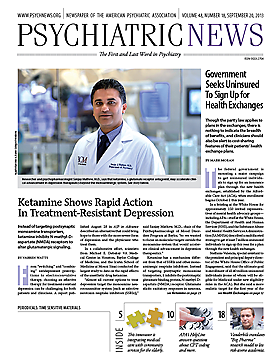Major depressive disorder (MDD) is a lifelong illness for a significant proportion of patients, with high rates of chronicity and recurrence. The median duration of an episode is six months. The likelihood of remaining depressed for many years is high (30 percent are still depressed after one year, 20 percent after two years, 12 percent after five years, 8 percent after 10 years, 6 percent after 15 years, and 4 percent after 30 years). The risk of recurrence after recovery is extremely high (36 percent after one year following recovery, 40 percent after two years, 60 percent after five years, 65 percent after 10 years, 85 percent after 15 years, and greater than 90 percent after 30 years).
Numerous continuation and maintenance studies found that a meaningful proportion of patients with MDD benefit substantially from long-term/maintenance treatment. The high rates of chronicity and recurrence led to consistent recommendations that the majority of patients with MDD should receive long-term treatment with medication and/or psychotherapy that have demonstrated efficacy.
The rest of this article will focus on clinical variables that often complicate the course in patients with MDD and must be actively monitored and treated.
Subsyndromal symptoms are present in the vast majority of individuals who recover from an episode of MDD, with or without treatment. The presence of these symptoms suggests that the MDD is still clinically active and unremitted. This leads to a significant increase in risk for early relapse into full criteria MDD and should not be interpreted as an apparent state of wellness by either the clinician or patient. The clinician must continue to treat these symptoms in an effort to bring the patient to an asymptomatic state.
Impairment in psychosocial functioning can be overlooked whether treating episodes of MDD or subsyndromal symptoms. It is essential that clinicians remain mindful of the evidence that depression, including minimal symptoms, has negative effects on psychosocial functioning. These impairments in functioning are known to increase and decrease with fluctuations in the severity of depression. Of critical importance is that these functioning impairments are associated with decreased likelihood of recovery and increased probability of recurrence of the MDD in those who do recover. Although successful treatment of depression is also likely to improve functioning, using modalities that specifically target impairment in functioning is indicated.
Conversion to bipolar disorder is another complicating variable in long-term treatment of MDD. Nearly 20 percent of adults first diagnosed with MDD will develop bipolar disorder during the course of three decades of follow-up. Higher rates of conversion have been found in children and adolescents, with reports of approximately 2.5 percent to 6.5 percent each year. Individuals with a history of psychosis, a family history of bipolar disorder, an earlier age at onset, and subthreshold hypomanic symptoms are at higher risk for developing bipolar disorder. However, the positive predictive value of these risk factors for individuals is limited. Consequently, close monitoring for the onset of hypomanic/manic symptoms is critical for all patients with MDD. If these symptoms are present, vigorous treatment of the symptoms should begin rapidly.
Severe anxiety symptoms develop in patients with MDD with a probability of at least 50 percent. These anxiety (psychic and somatic) symptoms are correlated with worse clinical course and worse treatment outcomes for MDD. Importantly, there is an increased risk of suicidality and suicide in the presence of anxiety symptoms (comorbid psychic anxiety, panic attacks, severe anxiety, and panic disorder) in those with MDD starting within a year. This has led to a unique addition of anxiety severity dimensions to the diagnosis of mood disorders in DSM-5. Consequently, clinicians must continually assess for the development and severity of comorbid anxiety and rigorously treat the anxiety as well as the depression and monitor both on a regular basis.
In summary, there has been an enormous amount of recent research on the long-term clinical course of MDD and on specific features that have a high probability of occurring over time. Those covered in this column are critical to understanding, anticipating, and treating common complications. The inclusion of measurement of anxiety severity in DSM-5 represents a major advance in the nomenclature for psychiatry and should have a meaningful positive impact on the assessment and treatment of MDD.
Patients, their families, and others in their support system should be given detailed information concerning the pernicious course of MDD and potential complicating risk factors. The need for adherence to the recommended treatment must be stressed as there are strong data that MDD has a very high rate of discontinuation of treatment and under treatment. ■

